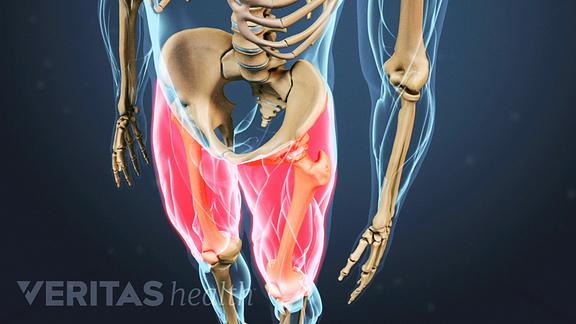
- updated: Apr. 14, 2022
- Neck Pain, Sleeping Tips, Spine Health, None
A warm feeling in the thigh may range from that of spilled warm milk to a hot, burning pain. The warmth may be localized to a specific area or may affect the entire thigh.
Depending on the underlying cause, warmth or pain in the thigh may occur in the front, outer and/or inner side, or the back of the thigh.
Several conditions can cause a warm feeling in the thigh, including nerve, muscle, and joint problems. Nerve pain may sometimes be felt as warmth, which may progress into sharp, searing pain in the later stages. Pain from muscles and joints may be felt as a warm sensation due to the inflammatory process of the underlying tissues.
Here are a few examples.
Radiculopathy
Nerve root irritation or compression near the spine can cause radicular pain or radiculopathy. Radiculopathy from the lumbar nerve roots L1-L4 may cause1:
- Pain along the outer side of the thigh, typically localized within a 5 to 8 cm wide area
- Numbness and weakness in the outer and/or inner thigh
When radicular pain from the spinal nerve roots radiates from the lower back into the thigh, leg, and/or foot, it is called sciatica. Sciatica usually caused when one or more nerve roots from L4 to S1 are affected.2
See What You Need to Know About Sciatica
Radicular pain typically affects one leg at a time and is caused due to nerve root compression from herniated lumbar disc, degeneration of spinal structures, or tumors.
See Lumbar Degenerative Disc Disease (DDD)
Meralgia paresthetica
When a nerve is compressed, entrapped, or degenerated along its path, is called neuropathy. Meralgia paresthetica is caused due to neuropathy of the lateral femoral cutaneous nerve, which is a superficial sensory nerve in the thigh.3 A few typical characteristics include4:
- Pain in the side and/or front of one or both thighs
- Buzzing or vibration felt inside the thigh
- Muscle ache and numbness in the thigh
See Understanding Neuropathy Symptoms
The pain may increase with prolonged standing and walking and reduce while sitting.4
Meralgia paresthetica is typically caused when a direct compression of the nerve occurs due to tight garments, pressure from seat belts, direct trauma, or muscle spasm in the hip. Other causes include damage to the nerve due to diabetes mellitus, alcoholism, and lead poisoning.4 Severe abdominal fat can also cause meralgia paresthetica.
Watch: Causes of Neuropathic Pain Video
Other types of nerve pain in the thigh include femoral and obturator neuropathy. Obturator nerve pain may produce symptoms in the inner thigh and femoral neuropathy usually causes symptoms from the thigh to travel down into the knee, leg, and/or foot.5
See Treatment Options for Neuropathic Pain
Greater trochanteric pain syndrome (GTPS)
GTPS is defined by a range of problems in the hip and may cause symptoms such as warmth or aches in the side of the thigh and hip. GTPS includes6:
- Tendinopathy: Chronic tendon pain
- External snapping hip: A muscle or tendon slides over the knobby bone at the top of the femur (thighbone), called the greater trochanter, causing pain and tenderness
See 3 Types of Snapping Hip Syndrome on Sports-health
- Trochanteric bursitis: Inflammation of the fluid-filled cavity present on the side of the hip
See Hip (Trochanteric) Bursitis on Arthritis-health
GTPS typically causes chronic intermittent pain in the side of the thigh, hip, and buttock. The pain increases with activity and while lying down on the affected side.6
Hip osteoarthritis
Wear-and-tear arthritis of the hip joint may cause warmth and other symptoms in the front and side of the thigh. A few symptoms include:
- Pain along the side and/or front of the thigh, groin, and hip7-8
- Stiffness in the hip8
- Locking, clicking, or grinding sound from the hip joint during movements8
See What Is Hip Osteoarthritis? on Arthritis-health
The pain and other symptoms typically increase with activity, after prolonged sitting, or after waking in the morning. Sometimes, the pain may radiate down to the knee.8
See Hip Osteoarthritis Symptoms on Arthritis-health
It is advised to consult a doctor if warmth, pain, or other symptoms develop in the thigh. If symptoms such as fever, nausea, difficulty walking or standing are resent, they may indicate serious underlying conditions, such as tumors, infection, or severe nerve damage. A doctor can diagnose the accurate cause of the symptom(s) and formulate an effective treatment plan.
See Accurately Diagnosing Leg Pain
Learn more:
Leg Pain and Numbness: What Might These Symptoms Mean?
Causes of Leg Pain and Foot Pain
References:
- Manchikanti L, Singh V, Boswell MV. Lumbar Radiculopathy. In: Pain Management. Elsevier; 2007:758-768. doi:10.1016/b978-0-7216-0334-6.50087-x.
- Wright R, Inbody SB. Radiculopathy and Degenerative Spine Disease. In: Neurology Secrets. Elsevier; 2010:121-130. doi:10.1016/b978-0-323-05712-7.00007-6.
- Ellis J, Schneider JR, Cloney M, Winfree CJ. Lateral Femoral Cutaneous Nerve Decompression Guided by Preoperative Ultrasound Mapping. Cureus. 2018;10(11):e3652. Published 2018 Nov 28. doi:10.7759/cureus.3652.
Coming soon.
This website includes materials that are protected by copyright, or other proprietary rights. Transmission or reproduction of protected items beyond that allowed by fair use, as defined in the copyright laws, requires the written permission of the copyright owners.






